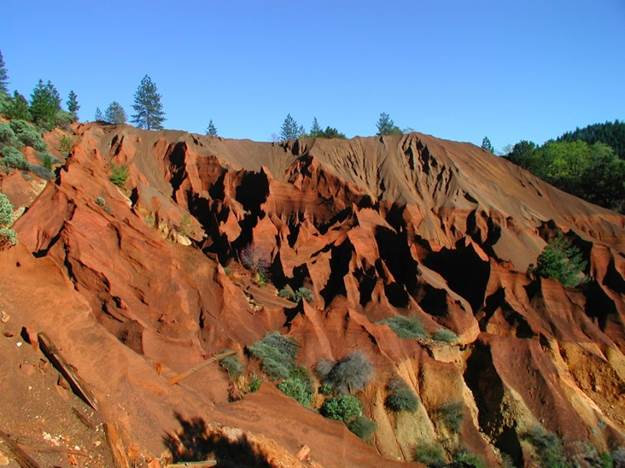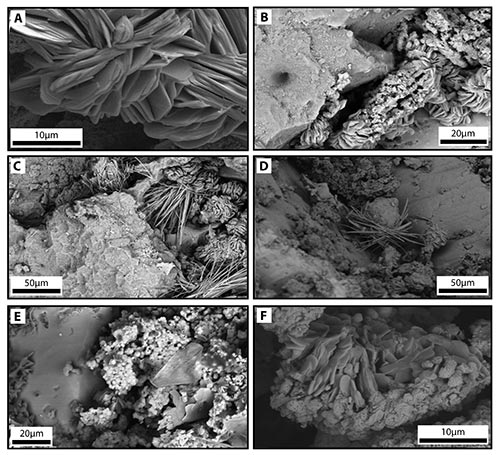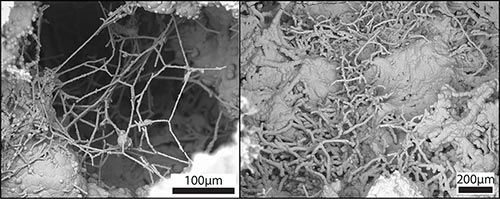Iron Mountain
Iron Mountain and the Red Planet

Gossan tailings (which have now been removed), with elevated arsenic, at the Iron Mountain Mine site. Gossan is a rock consisting mostly of iron oxides formed by weathering of rock originally greater than 50% iron sulfide (usually pyrite). "False gossan" occurs where iron is transported from its original location.

A plate of SEM images of FeSO4 salts from the surface gossan.A. Williams (U.C. Davis)

Two kinds of mineralized filaments from the surface gossan.
Intensely oxidized, "red" minerals found at Iron Mountain, collectively known as gossan, are thought to have formed in similar conditions to minerals on our neighboring red planet, Mars. The California Water Science Center is investigating the properties of the ancient iron oxides at Iron Mountain and using the site to gather information on the properties of minerals that have been observed or may be encountered on the surface of Mars.
Similarities between the mineralogy of Iron Mountain and portions of the Mars surface have motivated scientists to search for deeper parallels between the two sites. Of particular interest is the search for biosignatures -- evidence of minerals formed by living organisms. At Iron Mountain and other iron-rich deposits on Earth, there is clear evidence for the activity of iron-oxidizing bacteria, which leave behind distinct textures including filaments (hair-like structures) that can become encrusted with iron oxide minerals. Because the mineralogy at Iron Mountain can serve as an analogue for understanding the formation of iron oxides and sulfates on Mars, scientists are searching for evidence of biogenic mineral formation on Mars similar to the processes involved in the formation of gossan and iron-rich pipe scale at Iron Mountain. The extreme conditions at Iron Mountain provide a unique setting that has allowed significant scientific advances to be made in environmental geochemistry, mineralogy, microbiology, and Mars analogue studies.
Scientists with the Mars Curiosity Mission are currently working to characterize biosignatures in samples taken from Iron Mountain to assist with interpretation of mineral texture on Mars. Biogenic mineral formation research is being led by UC Davis graduate student, Amy Williams and her principal advisor, Prof. Dawn Sumner, who are members of NASA's Mars Science Laboratory (MSL) team. USGS scientists Charles Alpers, Kate Campbell, and D. Kirk Nordstrom are collaborating with the UC Davis researchers in this investigation.
Stakeholders


News
July 26, 2018
Public lecture: Iron Mountain, California: An Extreme Acid Mine Drainage Environment, presented by Charles Alpers, USGS Research Chemist
November 8, 2015
Preserved filamentous microbial biosignatures in the Brick Flat gossan, Iron Mountain, California
published in Astrobiology, Aug. 2015
Additional Mars Research
Amy Williams
Post-doctoral Research Associate
NASA Goddard Space Flight Center/
University of Maryland Baltimore County
TEDx UC Davis talk on "The Search for Evidence of Past Microbial Life on Mars" by Ph.D. candidate Amy Williams. A video of the presentation is now available online.
Professor Dawn Sumner
Mars Science Laboratory
NASA Mars Science Laboratory - Curiosity Rover
Related Resources
USGS National Research Program: Chemical Modeling of Acid Waters, Iron Mountain, Shasta County, CA
U.S. Environmental Protection Agency: Pacific Southwest Superfund, Iron Mountain Mine

Contacts
Project Chief: Charles Alpers
Phone: 916.278.3134
Email: cnalpers@usgs.gov
